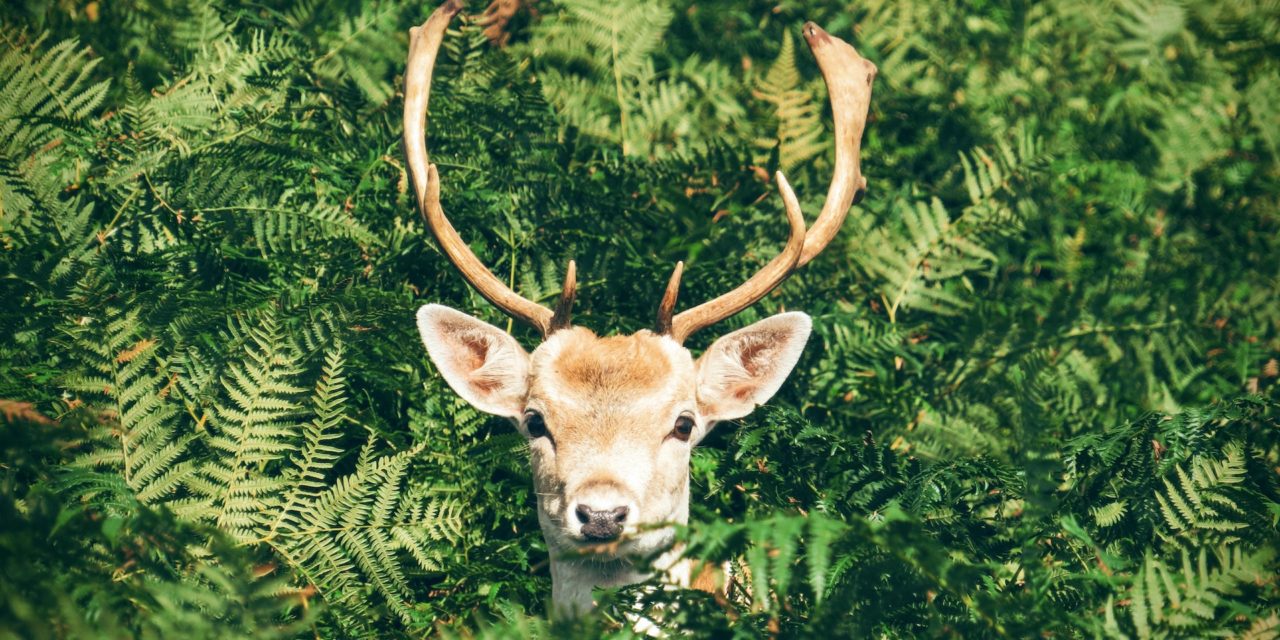We are pleased to be cross-posting this essay in collaboration with the online journal EcoTheo Review, which “celebrates wonder, enlivens conversations, and inspires commitments to ecology, spirituality, and art.” We urge you to visit their site, as we share many values in common!
A red oak acorn crunches under my foot and the sound ripples through the pre-dawn darkness on the forest path from the corner of the house. I stop in the woolen cold to listen. Starlight pulses through a few holes in the cloud cover in a way that embosses the thick arms of the oaks overhead. Just how many creatures have they fed over the generations in this place and what kinds? A twig snaps. In the back of my belly, I feel the hollow thudding of hooves in the red maple swamp below. White-tailed deer do not usually flee very far in the dark if they haven’t picked up human scent. The wind drifts upslope into my face, so I don’t think they smelled me.
I bump along the dark trail for a quarter mile and use a climbing tree stand to shimmy up the hard sides of a pignut hickory. Twenty feet above the ground, I settle into stillness. Light seeps onto the lake before it crawls into the woods. A flock of geese speak at the edge of the cattail marsh. The squirrels wrangle whatever it is they’re caching in the soil. I hear the yearling buck before I see him. His steps are of a different measured timbre than the squirrels. I watch him forage his way through the leaf litter for some time. He walks over the ridge and out of sight. I don’t know why, but a few minutes later he emerges in the same notch and walks a line right to me. He stops in a patch of frosted nettle to eat something.
He is close. I have a solid rest. I want to make sure not to lose any meat to bruising from the copper bullet, so I settle the crosshairs where his brainstem meets his spinal column. I take a deep breath in, exhale fully and hold. Focus. Squeeze.
His body falls and he dies there on the ground.
What exactly happens to all of us when we move from life to death? I want to give space and time for the transition so I wait in the tree for an hour before I make the descent. When I reach the deer, I kneel down next to him for a while to say sorry, and thanks. Then I shift my body around and lift his head to rest in my lap.
I pay attention to the silence that I caused by taking his life.
I think my seven-year-old daughter, Emerson, who suggested that I hunt this morning, will want to be part of the rest of the process, so I walk home. From the woods, I see her eating cereal in a kitchen chair she pulled in front of the woodstove. I open the sliding glass door and lean inside.
“You got a deer, didn’t you?” Emerson asks with confidence. She told me last night when I tucked her in that it would be so. “He’s beautiful. Would you like to help?” She runs upstairs to get dressed.
We walk out the back door. At the threshold of the forest, the wind swirls and casts beaded snow across frozen leaves. Emerson throws her arms in the air in response. We hear something else in the sheen of sound. Chins to the sky, we search for the troupes of sandhill cranes who speak to each other above the piebald clouds. We steep in this scene, then continue along the path.
When Emerson sees the deer, she jogs to him, pets his back and runs one of his ears through her fingers. I give her some time, and then I ask where she thinks we should take the deer to remove the organs from his body. She looks to the eastern sky.
“Right over there by the fairy pond,” she points rhythmically, “because there’s an open spot where the turkey vultures will be able to see the parts we won’t eat.” She appears to be thinking something over. “Will we get to see his lungs?” I assure her that we will and affirm her thoughtfulness about the birds.
Emerson, who is about two-thirds the size of the deer, grasps a back leg just above the hoof while I hold the other. We drag the deer a hundred yards or so and stop for a break at the top of a rise. She picks at the edge of his hoof with her thumbnail. “I’d really like to keep these hooves in my room if that’s ok.”
When we reach the place Emerson has chosen, I make sure the buck’s belly is pointed slightly downslope to have gravity work with us. I explain how and where to split the skin, just below the sternum, by reference to mine. I split the hide with the tip of my knife blade, and make a small slit into the animal’s muscle.
“Would you like to help me?” Emerson nudges closer and takes the handle of the knife. I guide her hand as we cut, slowly, most of the way to his hind legs.
I ask Emerson to hold up the two legs on his left side so I can sever the diaphragm and some of the connective tissue holding in the deer’s organs.
“Can I feel inside there before we take the parts out?” she asks. I pull the ribcage open as wide as I can, loosing a cloud of steam. She peers inside and threads her hand into the mystery. I hear the movement of her palpating fingers. She removes her hand from the deer’s body, looks closely at the blood on her fingers for a moment, and wipes it on her fleece.
I make a few more cuts, reach into his ribcage all the way back to the spine, and roll the organs out onto the ground in one bundle. We talk through the many parts, giving language to this sacred geography. We are wrapped in awe of the form, texture, and color of this inner landscape.
“Papa, I know that people think dead things are gross, but they’re not really seeing them. Do you see how this liver is purple lined with red? It feels so smooth. Do you think most people know that?”
“I think you have a very powerful way of seeing, Emerson.”
She reaches for the heart. I remove it from the pericardium, the sac-like structure that surrounds the muscle. We huddle close, kneel down together, and notice the white, purple, gray, crimson, teal, black, red, and blue. She traces the arteries with her fingertip the same way she attends to the forms of columbines, turns the heart over in her hand and gasps.
After some time, she whispers, “Are our hearts beautiful like this?” All I can do is nod.
The west wind rolls wood smoke down the path. Emerson shivers and glances back toward the house. “I need to draw a picture of this.” She runs home with the deer heart in her hands while I half-yell garbled instructions about where not to put it down inside the house. I lie down on my back for a time, then finish my work. On my way past the house, I glance through the sliding glass door. The heart is on a white plate in the center of the table.
That afternoon, Emerson and I examine the heart’s form. I pull out a topographic map to show her how the arteries flow in riverine patterns like water on earth. We feel inside the ventricles where blood pumped through. I slice the heart into cubes, simmer with olive oil, vidalia onion, garlic, and pink mineral salt. We savor the gift.
Once the buck is skinned and the meat is wrapped for the freezer, Emerson pulls the rest of him on a tarp to the edge of the field south of the house. I walk with her. “Let’s put him under the mulberry tree. It’s a pretty place,“ she says. “And we can see who comes to eat what’s left from the window,” I add. She stretches the hide back over the ribcage and arranges the leg bones as they once were. She touches his nose and looks into his eyes.
“Thanks for your meat, buck.”
Photo credit: Chris Greenhow

